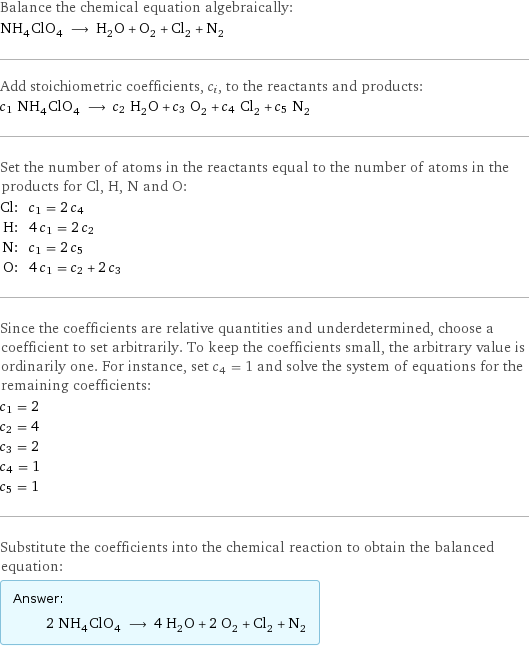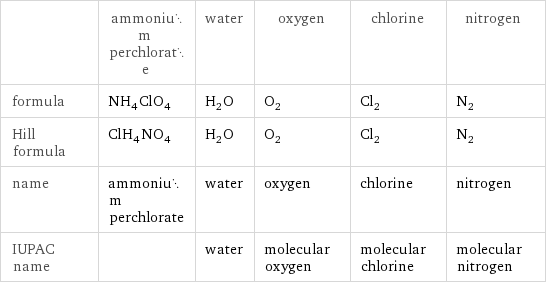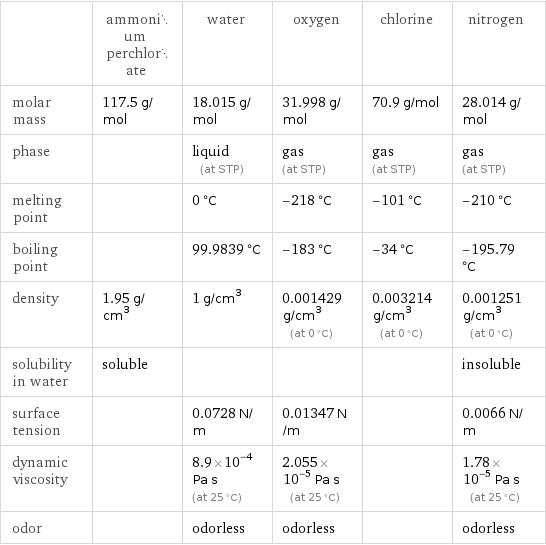Input interpretation

NH_4ClO_4 (ammonium perchlorate) ⟶ H_2O (water) + O_2 (oxygen) + Cl_2 (chlorine) + N_2 (nitrogen)
Balanced equation

Balance the chemical equation algebraically: NH_4ClO_4 ⟶ H_2O + O_2 + Cl_2 + N_2 Add stoichiometric coefficients, c_i, to the reactants and products: c_1 NH_4ClO_4 ⟶ c_2 H_2O + c_3 O_2 + c_4 Cl_2 + c_5 N_2 Set the number of atoms in the reactants equal to the number of atoms in the products for Cl, H, N and O: Cl: | c_1 = 2 c_4 H: | 4 c_1 = 2 c_2 N: | c_1 = 2 c_5 O: | 4 c_1 = c_2 + 2 c_3 Since the coefficients are relative quantities and underdetermined, choose a coefficient to set arbitrarily. To keep the coefficients small, the arbitrary value is ordinarily one. For instance, set c_4 = 1 and solve the system of equations for the remaining coefficients: c_1 = 2 c_2 = 4 c_3 = 2 c_4 = 1 c_5 = 1 Substitute the coefficients into the chemical reaction to obtain the balanced equation: Answer: | | 2 NH_4ClO_4 ⟶ 4 H_2O + 2 O_2 + Cl_2 + N_2
Structures

⟶ + + +
Names

ammonium perchlorate ⟶ water + oxygen + chlorine + nitrogen
Equilibrium constant
![Construct the equilibrium constant, K, expression for: NH_4ClO_4 ⟶ H_2O + O_2 + Cl_2 + N_2 Plan: • Balance the chemical equation. • Determine the stoichiometric numbers. • Assemble the activity expression for each chemical species. • Use the activity expressions to build the equilibrium constant expression. Write the balanced chemical equation: 2 NH_4ClO_4 ⟶ 4 H_2O + 2 O_2 + Cl_2 + N_2 Assign stoichiometric numbers, ν_i, using the stoichiometric coefficients, c_i, from the balanced chemical equation in the following manner: ν_i = -c_i for reactants and ν_i = c_i for products: chemical species | c_i | ν_i NH_4ClO_4 | 2 | -2 H_2O | 4 | 4 O_2 | 2 | 2 Cl_2 | 1 | 1 N_2 | 1 | 1 Assemble the activity expressions accounting for the state of matter and ν_i: chemical species | c_i | ν_i | activity expression NH_4ClO_4 | 2 | -2 | ([NH4ClO4])^(-2) H_2O | 4 | 4 | ([H2O])^4 O_2 | 2 | 2 | ([O2])^2 Cl_2 | 1 | 1 | [Cl2] N_2 | 1 | 1 | [N2] The equilibrium constant symbol in the concentration basis is: K_c Mulitply the activity expressions to arrive at the K_c expression: Answer: | | K_c = ([NH4ClO4])^(-2) ([H2O])^4 ([O2])^2 [Cl2] [N2] = (([H2O])^4 ([O2])^2 [Cl2] [N2])/([NH4ClO4])^2](../image_source/d1ba7149799861d0b165e63ce24a87e1.png)
Construct the equilibrium constant, K, expression for: NH_4ClO_4 ⟶ H_2O + O_2 + Cl_2 + N_2 Plan: • Balance the chemical equation. • Determine the stoichiometric numbers. • Assemble the activity expression for each chemical species. • Use the activity expressions to build the equilibrium constant expression. Write the balanced chemical equation: 2 NH_4ClO_4 ⟶ 4 H_2O + 2 O_2 + Cl_2 + N_2 Assign stoichiometric numbers, ν_i, using the stoichiometric coefficients, c_i, from the balanced chemical equation in the following manner: ν_i = -c_i for reactants and ν_i = c_i for products: chemical species | c_i | ν_i NH_4ClO_4 | 2 | -2 H_2O | 4 | 4 O_2 | 2 | 2 Cl_2 | 1 | 1 N_2 | 1 | 1 Assemble the activity expressions accounting for the state of matter and ν_i: chemical species | c_i | ν_i | activity expression NH_4ClO_4 | 2 | -2 | ([NH4ClO4])^(-2) H_2O | 4 | 4 | ([H2O])^4 O_2 | 2 | 2 | ([O2])^2 Cl_2 | 1 | 1 | [Cl2] N_2 | 1 | 1 | [N2] The equilibrium constant symbol in the concentration basis is: K_c Mulitply the activity expressions to arrive at the K_c expression: Answer: | | K_c = ([NH4ClO4])^(-2) ([H2O])^4 ([O2])^2 [Cl2] [N2] = (([H2O])^4 ([O2])^2 [Cl2] [N2])/([NH4ClO4])^2
Rate of reaction
![Construct the rate of reaction expression for: NH_4ClO_4 ⟶ H_2O + O_2 + Cl_2 + N_2 Plan: • Balance the chemical equation. • Determine the stoichiometric numbers. • Assemble the rate term for each chemical species. • Write the rate of reaction expression. Write the balanced chemical equation: 2 NH_4ClO_4 ⟶ 4 H_2O + 2 O_2 + Cl_2 + N_2 Assign stoichiometric numbers, ν_i, using the stoichiometric coefficients, c_i, from the balanced chemical equation in the following manner: ν_i = -c_i for reactants and ν_i = c_i for products: chemical species | c_i | ν_i NH_4ClO_4 | 2 | -2 H_2O | 4 | 4 O_2 | 2 | 2 Cl_2 | 1 | 1 N_2 | 1 | 1 The rate term for each chemical species, B_i, is 1/ν_i(Δ[B_i])/(Δt) where [B_i] is the amount concentration and t is time: chemical species | c_i | ν_i | rate term NH_4ClO_4 | 2 | -2 | -1/2 (Δ[NH4ClO4])/(Δt) H_2O | 4 | 4 | 1/4 (Δ[H2O])/(Δt) O_2 | 2 | 2 | 1/2 (Δ[O2])/(Δt) Cl_2 | 1 | 1 | (Δ[Cl2])/(Δt) N_2 | 1 | 1 | (Δ[N2])/(Δt) (for infinitesimal rate of change, replace Δ with d) Set the rate terms equal to each other to arrive at the rate expression: Answer: | | rate = -1/2 (Δ[NH4ClO4])/(Δt) = 1/4 (Δ[H2O])/(Δt) = 1/2 (Δ[O2])/(Δt) = (Δ[Cl2])/(Δt) = (Δ[N2])/(Δt) (assuming constant volume and no accumulation of intermediates or side products)](../image_source/ceea49562b86b1ba7e697de76137e988.png)
Construct the rate of reaction expression for: NH_4ClO_4 ⟶ H_2O + O_2 + Cl_2 + N_2 Plan: • Balance the chemical equation. • Determine the stoichiometric numbers. • Assemble the rate term for each chemical species. • Write the rate of reaction expression. Write the balanced chemical equation: 2 NH_4ClO_4 ⟶ 4 H_2O + 2 O_2 + Cl_2 + N_2 Assign stoichiometric numbers, ν_i, using the stoichiometric coefficients, c_i, from the balanced chemical equation in the following manner: ν_i = -c_i for reactants and ν_i = c_i for products: chemical species | c_i | ν_i NH_4ClO_4 | 2 | -2 H_2O | 4 | 4 O_2 | 2 | 2 Cl_2 | 1 | 1 N_2 | 1 | 1 The rate term for each chemical species, B_i, is 1/ν_i(Δ[B_i])/(Δt) where [B_i] is the amount concentration and t is time: chemical species | c_i | ν_i | rate term NH_4ClO_4 | 2 | -2 | -1/2 (Δ[NH4ClO4])/(Δt) H_2O | 4 | 4 | 1/4 (Δ[H2O])/(Δt) O_2 | 2 | 2 | 1/2 (Δ[O2])/(Δt) Cl_2 | 1 | 1 | (Δ[Cl2])/(Δt) N_2 | 1 | 1 | (Δ[N2])/(Δt) (for infinitesimal rate of change, replace Δ with d) Set the rate terms equal to each other to arrive at the rate expression: Answer: | | rate = -1/2 (Δ[NH4ClO4])/(Δt) = 1/4 (Δ[H2O])/(Δt) = 1/2 (Δ[O2])/(Δt) = (Δ[Cl2])/(Δt) = (Δ[N2])/(Δt) (assuming constant volume and no accumulation of intermediates or side products)
Chemical names and formulas

| ammonium perchlorate | water | oxygen | chlorine | nitrogen formula | NH_4ClO_4 | H_2O | O_2 | Cl_2 | N_2 Hill formula | ClH_4NO_4 | H_2O | O_2 | Cl_2 | N_2 name | ammonium perchlorate | water | oxygen | chlorine | nitrogen IUPAC name | | water | molecular oxygen | molecular chlorine | molecular nitrogen
Substance properties

| ammonium perchlorate | water | oxygen | chlorine | nitrogen molar mass | 117.5 g/mol | 18.015 g/mol | 31.998 g/mol | 70.9 g/mol | 28.014 g/mol phase | | liquid (at STP) | gas (at STP) | gas (at STP) | gas (at STP) melting point | | 0 °C | -218 °C | -101 °C | -210 °C boiling point | | 99.9839 °C | -183 °C | -34 °C | -195.79 °C density | 1.95 g/cm^3 | 1 g/cm^3 | 0.001429 g/cm^3 (at 0 °C) | 0.003214 g/cm^3 (at 0 °C) | 0.001251 g/cm^3 (at 0 °C) solubility in water | soluble | | | | insoluble surface tension | | 0.0728 N/m | 0.01347 N/m | | 0.0066 N/m dynamic viscosity | | 8.9×10^-4 Pa s (at 25 °C) | 2.055×10^-5 Pa s (at 25 °C) | | 1.78×10^-5 Pa s (at 25 °C) odor | | odorless | odorless | | odorless
Units
